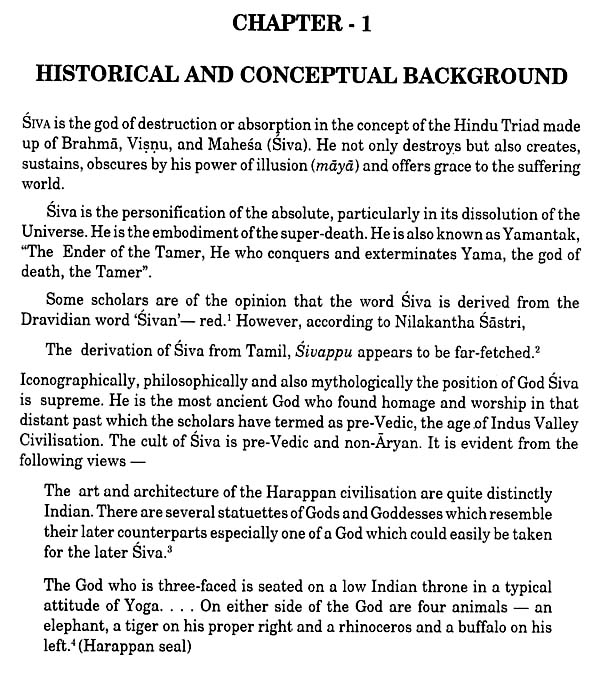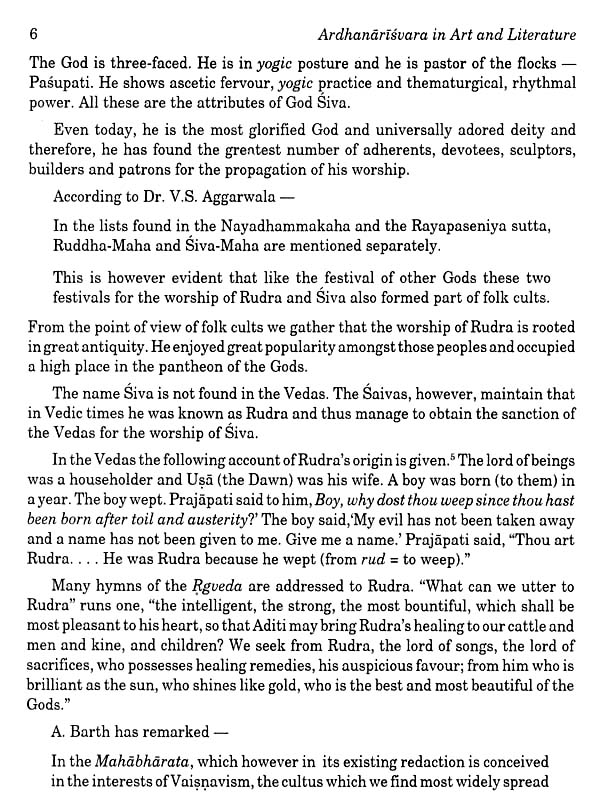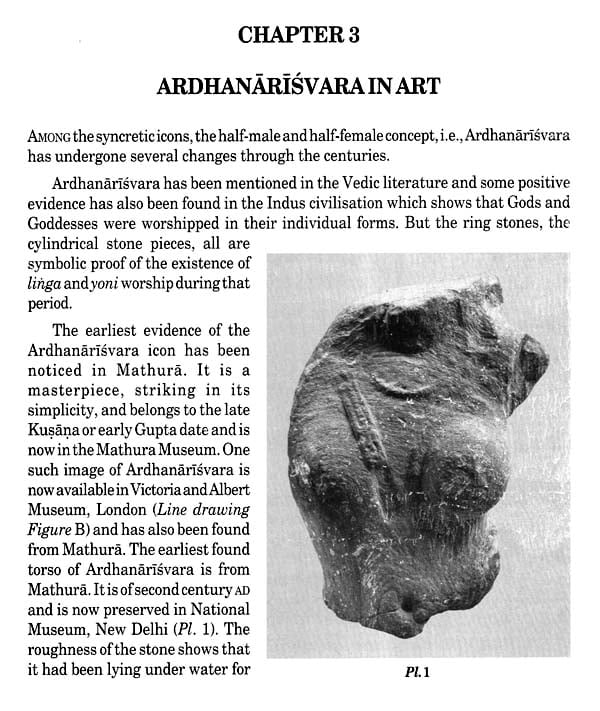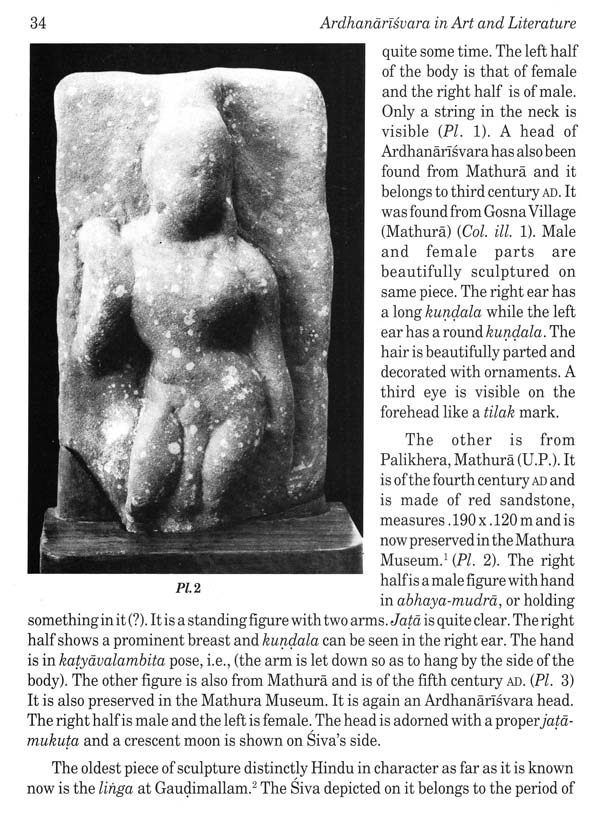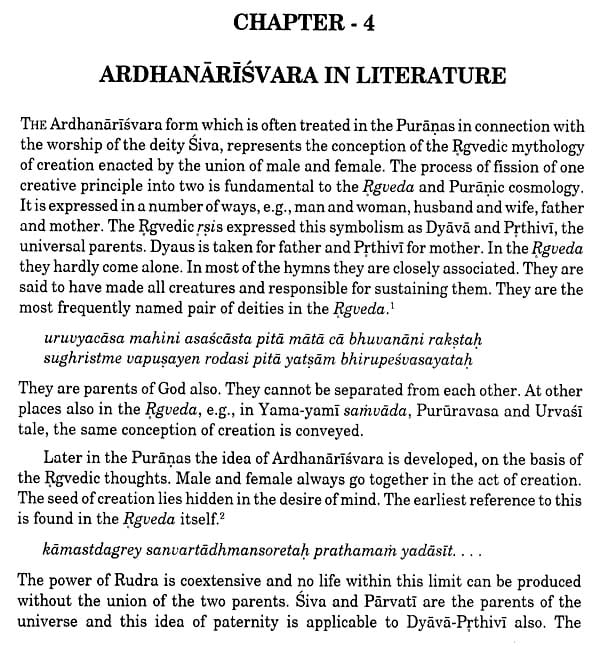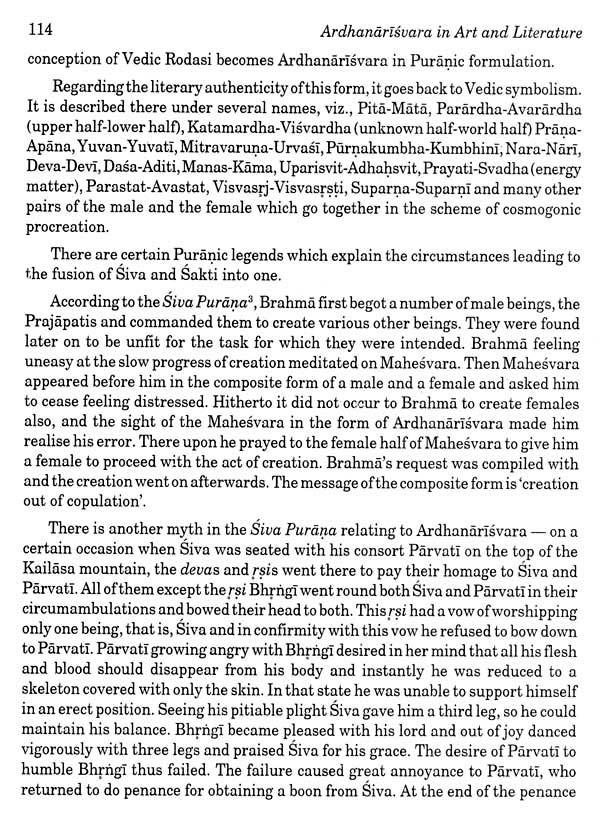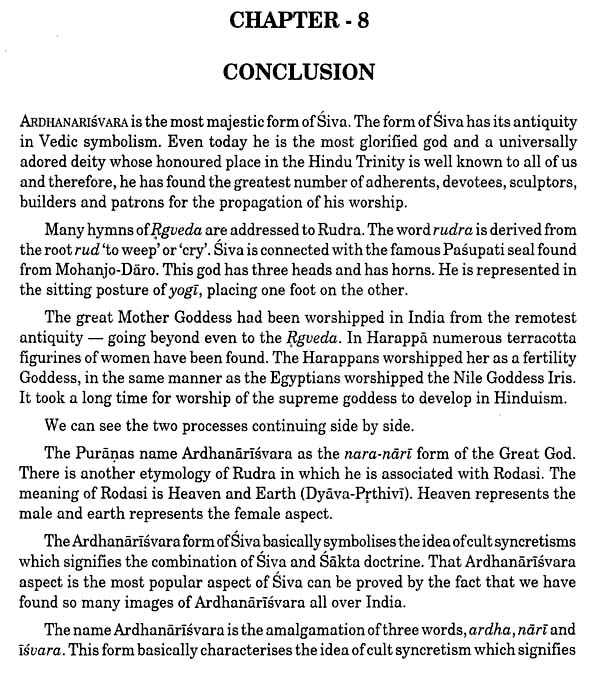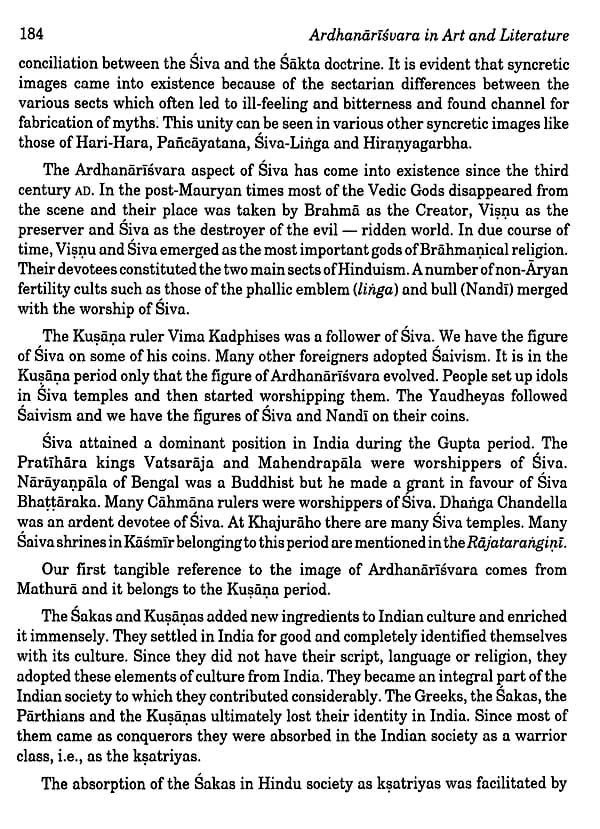
Ardhanarisvara (Ardhanarishvara) in Art and Literature
Book Specification
| Item Code: | IDD160 |
| Author: | Neeta Yadav |
| Publisher: | D. K. Printworld Pvt. Ltd. |
| Language: | English |
| Edition: | 2001 |
| ISBN: | 8124601690 |
| Pages: | 278 (Col.illus.: 18, B&W.illus.: 70 and 9 Maps) |
| Cover: | Hardcover |
| Other Details | 9.75" X 7.4" |
| Weight | 920 gm |
Book Description
About the Book:
The scholarly work throws light on the artistic, aesthetic, literary and philosophical aspects of the Ardhanarisvara form of Siva - the form which is a divine expression of the amalgamation of the male and the female and is said to contain the whole world in it. Providing a conceptual and historical back-ground of the doctrines relating to Siva and Sakti worship - it involves an iconographical study of the Ardhanarisvara image, with the focus on its dress, ornaments, coiffure, posture and other features. With many visuals of the Ardhanarisvara images - even the unpublished ones, it described the images found in different parts of India and discusses the emergence of the deity relying on literary sources and theories.
Explaining how the idea and actual representation of the unity of Siva and Sakti came to acquire supreme importance with the growth of sects - each worshipping the deity in its own form, Dr. Yadav points out that the Ardhanarisvara aspect is basically the output of the Tantra philosophy. Providing maps and line-drawings and a list of the places that have yielded Ardhanarisvara images, she makes an interesting and in depth analysis, based on extensive field-work, to come up with some brilliant and new explanations for the meaning and implications of the Ardhanarisvara.
About the Author:
Dr. Yadav, a Ph.D. in History, is an emerging young scholar of distinction who is deeply involved in research on the meaning and concept of the Ardhanarisvara in Indian history and culture. A prolific writer, she has, to her credit, seminar presentations on the sculptural tradition of Ardhanarisvara pertaining to different regions of India.
It is a matter of pleasure for me to write a foreword for the book Ardhanarisvara in Art and Literature a comprehensive research done by Dr. Neeta Yadav.
The beauty of her work lies in the fact that she has explored all aspects of Ardhanarisvara Siva. The ideas have their origin in the hoary past. Ancient Egypt presents the tradition in the form of Ankusa Dr. Yadav rightly thinks that it is the physical expression of the ancient concept of the amalgamation of male and female.
She begins by distinguishing between religion and art. She has tried to identify the legendary philosophical and religious aspects of the image.
Dr. Yadav has some brilliant and refreshingly new explanations for the meaning and implications of the conception of divine Censorship. She seeks to interpret it in a novel way without deviating from the earlier views.
Art historians have cited various meanings to these images but on one has discussed it so vividly as Dr. Yadav has done. She has very enthusiastically dealt with the tantric and aesthetic backgrounds of these images. As a result of her extensive field work she has included some unpublished images too. It would have been appropriate is she could have studied and included paintings as well. This however does not diminish the value of the work.
I am certain that both art critics and naïve readers will find this work extremely fascinating.
It is a matter of gratification for me to place in the hands of my readers a work which is appreciated by my revered guru Dr. Anamika Roy, Lecturur in the Department of Ancient History culture and Archeology, Allahabad University Allahabad who so patiently and cheerfully guided prodded and wheedled me into completing this study in time. I acknowledge my deep indebteness to Dr. Sushmita Pandey and all my teachers, Dr. U.N. Roy, Dr. S.N. Roy, Dr. V.D. Mishra, Dr. S.C. Bhattacharya, Dr. H.N. Dubey, Dr. R.S. Tripathi, Dr. Om Prakash, Dr. Ranjana Vajpayee, Dr. Pushpa Sing, Dr. J.N. Pal, Dr. G.K. Rai. Dr. O.P. Srivastava of the Department all of whome helped me affectionately in various ways at critical of my higher studies.
I had always been taken to study the image of our almighty God as Ardhanarisvara as this form contains the whole in it. The essence of human existence is unity which is very beautifully depicted in this composite form of Ardhanarisvara.
Here I have tried my level best to describe all the aspects of Ardhanarisvara in Indian Art and Literature. I hope this work of mine will be of great help to research scholars and students of history.
Although I have visited a number of historical sites personally it is still possible that I might not have seen some significant images of Ardhanarisvara in other areas besides all those which I have mentioned in the text.
Ardhanarisvara Siva has been of great importance right from the beginning. Most of the images are of stone and a very few bronze images have been found. Ardhanarisvara is also depreciated on the coins and seals. Unfortunately I was not able to gather the coins as they are in private collections and are not easily available. However inspite of such non availability. I have tried my best to describe the presence of Ardhanarisvara on coins in this text by giving references.
I am conscious that the work may not be free from shortcomings both in the presentation of facts and in the conclusion derived from them. For all these the author only craves the indulgence of the reader.
I am extremely grateful to an eminent educationist Lt. Col. A.N. Tripathi Principal Army School Jhansi who despite his busy schedule shared his vast knowledge and invaluable experience with me and provided me with that little extra bit which has made all the differences to this study.
I cannot fail to express my deep sense of gratitude to Rama Shankar ji, R.O. Antiquities Maj. Gen Kulwant Singh (Retd.) Mr. Ravi Shankar, Late Ms. Pushpa Thakurail, Dr. Ambika Singh and Dr. LEeela Kenal for their valuable suggestions to make the wok up to date.
I am indebted to the American Institute of Indian Studies Gurgaon for supplying me the necessary photographs together with the permission for reproducing and publishing them.
I am thankful to the directors of all the museums I have visited during my entire study.
I would never fail to express my gratitude to my parents Mr. P.L. Yadav and Ms. Savitri Yadav my brother Maj. D.K. Yadav and Lt. P.K Yadav and my sisters Damyanti, Poonam and Pushpa who helped me in the completion of this work and financially supported me as and when required.
Last but not least I express my overriding debt to my husband Mr. K.L. Nigam and my sweet daughter Pragya who accepted without apparent resentment and with barely audible complaint my complete self isolation during the surveys when I totally and shamefully neglected them.
Siva is worshipped in India from the remotest antiquity, to show which facts are available from the Indus valley civilization itself. Saivism is a popular religion of India along with Vaisnavism and Saktism. It gained ground during the ScythoKusana period and then developed in various forms all over India.
Saktism is a different religion followed by those adhering to strict Brahmanism. The combination of the two main religious sects into one is a major incident in the history of religions.
The Ardhanariávara concept basically symbolizes the idea of cult syncretism. That Siva, a non-Aryan tribal God, merged with Sakti, a pure Brahmanical deity, is itself an important factor. This shows the strong feeling of religious tolerance. Ardhanarisvara signifies the half-male and half-female aspect of Siva and Sakti.
Numerous images of Ardhanarivara are scattered all over the extensive dominion which has been witnessed to the love of the people of that time towards s syncretic ideology. It also indicates that sculptural art received liberal patronization. The sculptures of Ardhanarthvara with various attendants and ganas were profusely carved at public places and temples.
No serious attempt that have been made so far to study the various aspects of Ardhanarisvara form of Siva in Indian Art. It has always been taken as a minor topic by the leading scholars and no detailed study has been furnished till now.
The efforts that have been made to study the Ardhanarisvara aspect have mainly centered around either literary sources or the Ardhanarisvara of a particular region. T.A. Gopinath Rao had given eight such photographs which show a clear picture of Ardhanarisvara deity of that particular region.
Composite deities have been discussed by eminent writers like S.L. Nagar, C. Sivaramamurthi T.A. Gopinath Rao and many others but a particular deity needs to be discussed in detail.
Various religions have been discussed side by side but the fusion of two religions sects has not been completely discussed so far.
Looking at the importance of this aspect of God Siva many scholars have given, a detailed account of few Ardhanarisvara images of a particular region.
The source material for this work has been collected by conducting a village-to- village survey of the ancient sites. Most of the ancient sites were surveyed for the purpose of conducting a comparative study also. Along with the Ardhanurisvara images, other images too were keenly studied for a proper knowledge of the different attributes of the different religions and differences between the various gods and goddesses.
The sites visited in this connection were the Delhi, Mathura, Lucknow, Khajuraho, Varanasi, Allahabad, Jhansi, Baruasagar, Gwalior, Morena, Agra, Datia, Bhubaneswar, Lalitpur, Devgarh, Tikamgarh, Abaneri, Dhubela, Sunhania in M.P., Kakanmath in M.P. and Geraha in U.P. Most of the photographs of the extreme south and eastern region are provided by the American Institute of Indian Studies, Varanasi. Besides various museums were visited to study the sculptures preserved there in.
Contemporary epigraphical evidence have been utilized whenever it was necessary. Evidence provided by the works of Panini, Kautilya, Patanljali have been utilized to study the socio-religious background. The works of Kalidasa have provided the background evidence for social and religious customs, fashion, dress, ornaments and hair styles.
The Natyasastra of Bharatamuni, Brhatsathhitá of Varahamihira and Kadambari of Bana are other sources that have proved to be of immense value in the interpretation of the social and cultural life of the people.
The present work has been divided into eight chapters. The first chapter deals with a brief historical background of Siva and Sakti doctrines and the basic idea behind the Ardhanarisvara deity.
Chapter two presents an iconographical study of Aiva ArdhanarThvara. It deals with dress, ornament and coiffure.
Chapter three is devoted to Ardhanãrisvara in Art. The various images that have been found are discussed along with the plates.
| Foreword | v | |
| Preface | vii | |
| Abbreviations | xi | |
| List of Visuals | xiii | |
| Transliteration Chart | xxiii | |
| Introduction | 1 | |
| 1 | Historical and Conceptual Background | 5 |
| 2 | Iconography of Ardhanarisvara | 17 |
| 3 | Ardjamarisvara in Art | 33 |
| 4 | Ardhanarisvara in Literature | 113 |
| 5 | An Aesthetic Approach | 131 |
| 6 | Socio Religious Background | 145 |
| 7 | Tantricism | 163 |
| 8 | Conclusion | 183 |
| Find Spots of Ardhanarisvara in India | 191 | |
| Appendix | 197 | |
| Maps | 201 | |
| 1. Map Showing Different ruling dynasties in India | 202 | |
| 2. Ardhanarisvara found in India fifth century AD and Before | 203 | |
| 3. Ardhanarisvara found in the sixth century AD | 204 | |
| 4. Ardhanarisvara found in the seventh century AD | 205 | |
| 5. Ardhanarisvara found in India the eighth century AD | 206 | |
| 6. Ardhanarisvara found in India the Ninth century AD | 207 | |
| 7. Ardhanarisvara found in India the tenth century AD | 208 | |
| 8. Ardhanarisvara found in India the eleventh century AD | 209 | |
| 9. Ardhanarisvara found in India the twelfth century AD and later | 210 | |
| Figures | 211 | |
| A. Ardhanarisvara from Thomas Inman’s Ancient Faith | 212 | |
| B. Siva Ardhanarisvara third century AD Red Sandstone Mathura | 213 | |
| C. Headresses of Ardhanarisvara | 214 | |
| D. Mukutas of Ardhanarisvara | 215 | |
| E. Headresses of Ardhanarisvara | 216 | |
| F. Ear Ornaments of Ardhanarisvara | 217 | |
| G. Tridents | 218 | |
| H. Other Implements | 219 | |
| I. Axes, Khadvanga, Damru, Skull, Snake, etc | 220 | |
| J. Mirrors in the hands of Devi | 221 | |
| K. Kamandalas | 222 | |
| L. Flowers | 223 | |
| M. Other Attributes | 224 | |
| N. Standing Poses and Ornaments of Ardhanarisvara | 225 | |
| O. Standing images of Ardhanarisvara showing Vanmala | 226 | |
| P. Standing Poses of Ardhanarisvara | 227 | |
| Q. Standing Posed of Ardhanarisvara | 228 | |
| R. Seated in Lalitasana and Standing pose of Ardhanarisvara | 229 | |
| S. Sitting pose of Ardhanarisvara | 230 | |
| T. Sitting Poses of Ardhanarisvara | 231 | |
| Glossary | 233 | |
| Bibliography | 241 | |
| Index | 247 |
